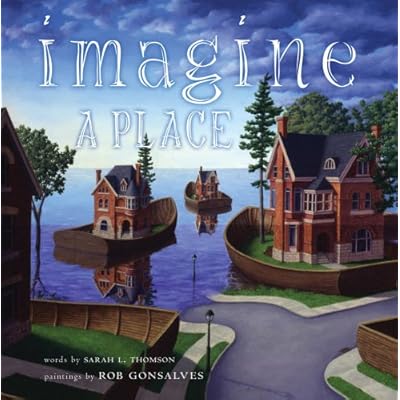 This lesson flowed very easily from the book which is its focus: Imagine a Place, authored by Sarah Thomson and illustrated by Rob Gonsalves. But this lesson can be done with many picture books so long as they have an overarching theme, are not narratives with chronological sequences of events and, preferably, have spectacular imagery.
This lesson flowed very easily from the book which is its focus: Imagine a Place, authored by Sarah Thomson and illustrated by Rob Gonsalves. But this lesson can be done with many picture books so long as they have an overarching theme, are not narratives with chronological sequences of events and, preferably, have spectacular imagery. Imagine a Place has brilliant, poetic and exquisite language that commences on every page with 'Imagine a place where...'. This is combined with incredible artwork that merges one everyday aspect of life like a house with a peaceful out-of-the-ordinary scene such as a wooden boat drifting away. The result is an astounding scene on every page, challenging the boundaries of children's imagination and the limits we regularly place on our concept of reality.
- their language, in this case poetry: its consciseness, flow and use of vocabulary of particular relevance to their scene
- the creativity of their scene, in this case most importantly its naturalism and ability to merge two elements of life that do not regularly go together and nevertheless appear 'real'
If you know your students' focus is going to be consumed by the artwork, have them create their idea first, draft their art in very rough form with a greylead pencil only, and then write their poem. Once they've done this, they can present it to you, briefly conference improvements, then work on their final version.
By doing this, students focus on quality (as opposed to quantity) writing and demonstrate their understanding of the nature of the text by engaging in one the highest levels of thinking: creating their own version of the author's text. At the end, all the students' work can be compiled into your own class Imagine a Place book.
I'll upload my attempt at this task below after Christmas. Leading on from the reflection post on Role-Models/Modelling (22 December 1), this a perfect example of a task where the teacher could have a go, before or during the lesson, at actually doing the work alongside the students and thereby model the desired standard of work.
How do you usually teach your students about the theme and writing style of books you read as a class?
What do you think about this type of lesson? Have you tried something like this before? How did it go?
No comments:
Post a Comment